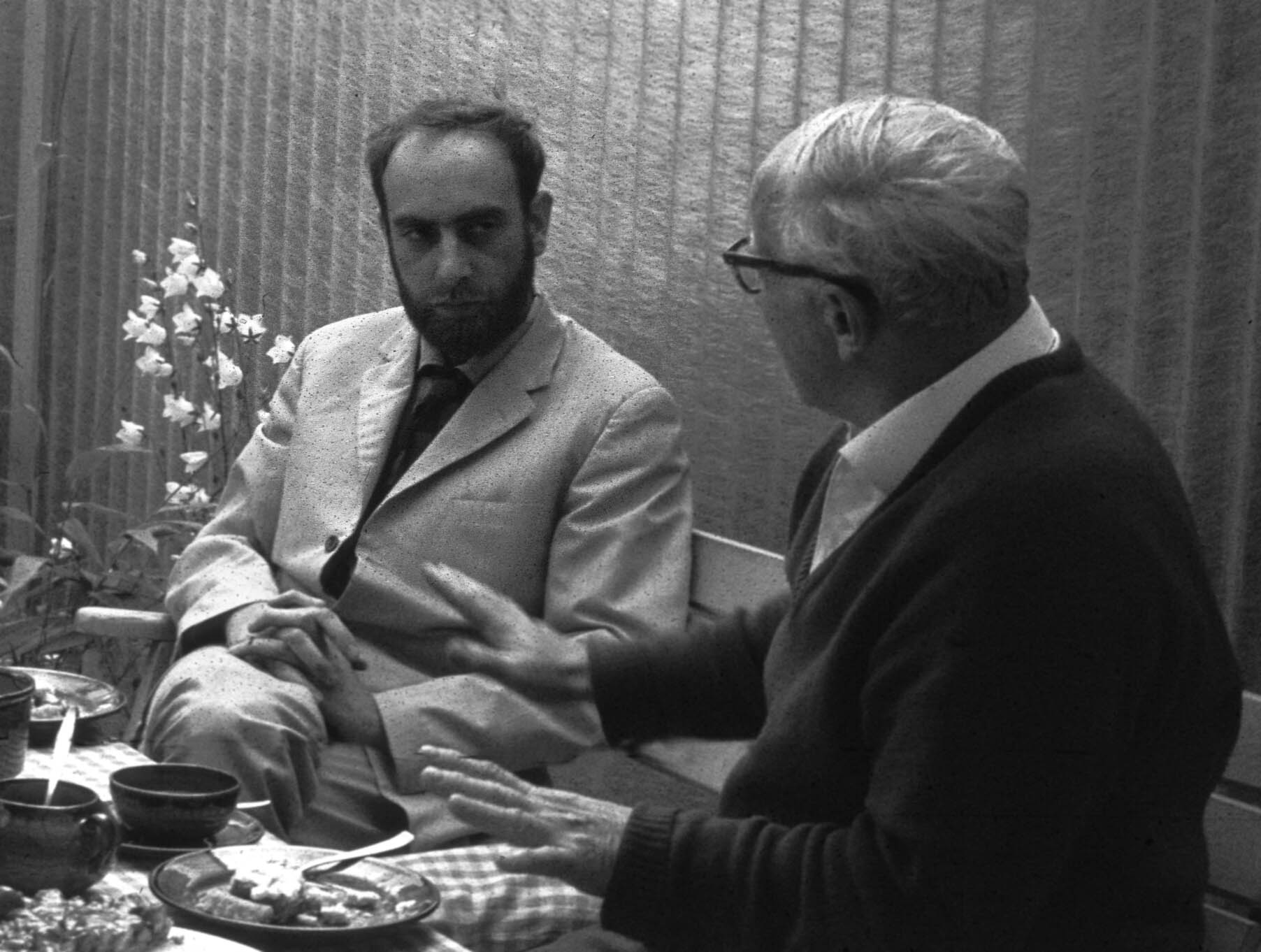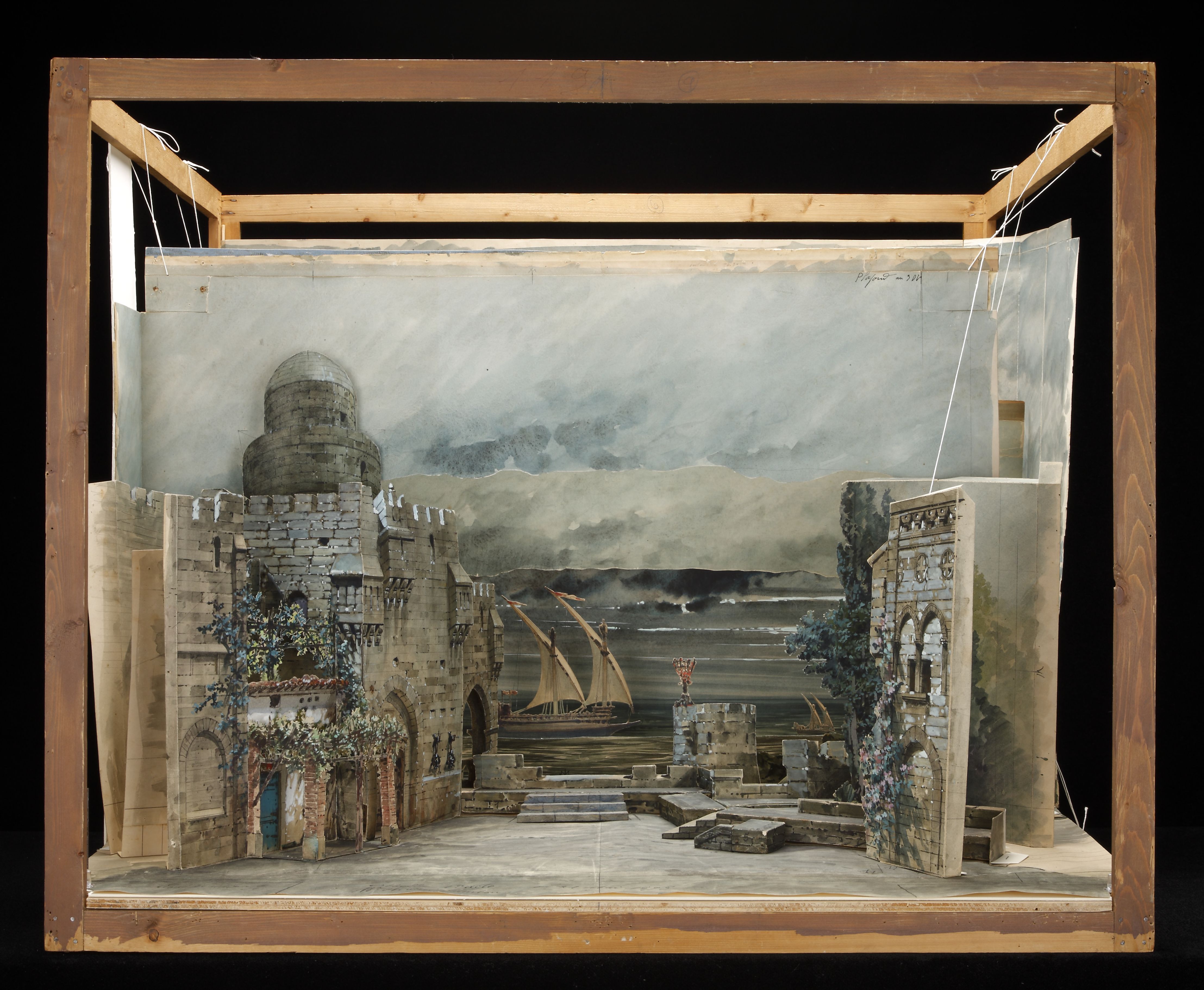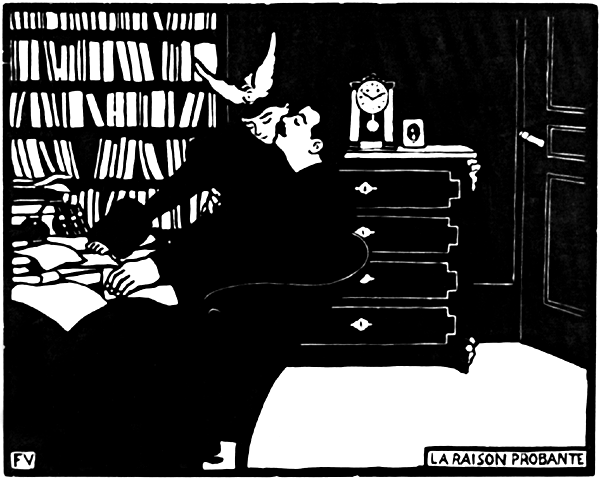|
Vjekoslav Vojo Radoičić
Vjekoslav Vojo Radoičić, also known as Vojo Radoičić (10 November 1930 – 15 July 2017), was a Croatian painter, sculptor, printmaker, and stage designer. He was born in Požega while Croatia was still under the Kingdom of Yugoslavia. He lived and worked in Vienna, London and Zagreb, and had close and intimate ties with those places as depicted in his artwork, however he spent most of his time in Rijeka, Croatia. Vojo Radoicic has held more than 180 independent exhibitions in Croatia, as well as abroad. He was known for depicting the places he has traveled to in vibrant colors through a child's mindset to tell stories of his experiences. He was awarded the Order of Croatian Danica for contributions to culture. Early life Vojo Radoičić was born in Požega in 1930, he later moved to Zagreb as a boy and lived there during the second world war. He attend primary school in Zagreb and has fond memories of his teachers and classmates. He moved to Rijeka to attend the Rijeka Mari ... [...More Info...] [...Related Items...] OR: [Wikipedia] [Google] [Baidu] |
Požega, Croatia
Požega () is a city in western Slavonia, eastern Croatia, with a total population of 22,364 (census 2021). It is the administrative center of the Požega-Slavonia County. Name Between 1921 and 1991, the town was known as ''Slavonska Požega''. In German language, German, the town is known as ''Poschegg'', in Hungarian language, Hungarian as ''Pozsega'', in Turkish language, Turkish as ''Pojega'', and in Latin language, Latin as ''Incerum'' (-i, n.) and ''Possega''. There is a town in Serbia with same name (see: Požega, Serbia). "Požega" is supposed to be related to the Croatian word "požar", meaning "forest fire". "Incerum" is supposed to come from Proto-Indo-European words *h1eyn (valley) and *kjer (heart), so that it means "the heart of the valley". Geography Požega (elevation: ) is located in the south-western part of the Valley of Požega, or Požega basin, in Croatian: ''Požeška kotlina''. This fertile valley has been important since the antiquity - its Ancient Rome, ... [...More Info...] [...Related Items...] OR: [Wikipedia] [Google] [Baidu] |
Friedensreich Hundertwasser
Friedrich Stowasser (15 December 1928 – 19 February 2000), better known by his pseudonym Friedensreich Regentag Dunkelbunt Hundertwasser (), was an Austrian visual artist and architect who also worked in the field of environmental protection. He emigrated to the Far North of New Zealand in the 1970s, where he lived and worked for most of the rest of his life. Hundertwasser stood out as an opponent of "a straight line" and any standardisation, expressing this concept in the field of building design. His best known work is the Hundertwasserhaus in Vienna, which has become a notable place of interest in the Austrian capital, characterised by imaginative vitality and uniqueness. Biography The Nazi era was a very hard time for Hundertwasser and his mother Elsa, who were Jewish. They avoided persecution by posing as Christians, a credible ruse as Hundertwasser's father had been a Catholic. Hundertwasser was baptized as a Catholic in 1935. To remain inconspicuous, Hundertwasser ... [...More Info...] [...Related Items...] OR: [Wikipedia] [Google] [Baidu] |
2017 Deaths
This is a list of lists of deaths of notable people, organized by year. New deaths articles are added to their respective month (e.g., Deaths in ) and then linked below. 2025 2024 2023 2022 2021 2020 2019 2018 2017 2016 2015 2014 2013 2012 2011 2010 2009 2008 2007 2006 2005 2004 2003 2002 2001 2000 1999 1998 1997 1996 1995 1994 1993 1992 1991 1990 1989 1988 1987 1986 Earlier years ''Deaths in years earlier than this can usually be found in the main articles of the years.'' See also * Lists of deaths by day * Deaths by year (category) {{DEFAULTSORT:deaths by year ... [...More Info...] [...Related Items...] OR: [Wikipedia] [Google] [Baidu] |
1930 Births
Events January * January 15 – The Moon moves into its nearest point to Earth, called perigee, at the same time as its fullest phase of the Lunar Cycle. This is the closest moon distance at in recent history, and the next one will be on January 1, 2257, at . * January 26 – The Indian National Congress declares this date as Independence Day, or as the day for Purna Swaraj (Complete Independence). * January 28 – The first patent for a field-effect transistor is granted in the United States, to Julius Edgar Lilienfeld. * January 30 – Pavel Molchanov launches a radiosonde from Pavlovsk, Saint Petersburg, Slutsk in the Soviet Union. February * February 10 – The Việt Nam Quốc Dân Đảng launch the Yên Bái mutiny in the hope of ending French Indochina, French colonial rule in Vietnam. * February 18 – While studying photographs taken in January, Clyde Tombaugh confirms the existence of Pluto, a celestial body considered a planet until redefined as a dwarf planet ... [...More Info...] [...Related Items...] OR: [Wikipedia] [Google] [Baidu] |
Dalmatia
Dalmatia (; ; ) is a historical region located in modern-day Croatia and Montenegro, on the eastern shore of the Adriatic Sea. Through time it formed part of several historical states, most notably the Roman Empire, the Kingdom of Croatia (925–1102), Kingdom of Croatia, the Republic of Venice, the Austrian Empire, and presently the Croatia, Republic of Croatia. Dalmatia is a narrow belt stretching from the island of Rab (island), Rab in the north to the Bay of Kotor in the south. The Dalmatian Hinterland ranges in width from fifty kilometres in the north, to just a few kilometres in the south; it is mostly covered by the rugged Dinaric Alps. List of islands of Croatia, Seventy-nine islands (and about 500 islets) run parallel to the coast, the largest (in Dalmatia) being Brač, Pag (island), Pag, and Hvar. The largest city is Split, Croatia, Split, followed by Zadar, Šibenik, and Dubrovnik. The name of the region stems from an Illyrians, Illyrian tribe called the Dalmatae, w ... [...More Info...] [...Related Items...] OR: [Wikipedia] [Google] [Baidu] |
Croatian Artists
Croatian may refer to: *Croatia *Croatian language *Croatian people *Croatians (demonym) See also * * * Croatan (other) * Croatia (other) * Croatoan (other) * Hrvatski (other) * Hrvatsko (other) * Serbo-Croatian (other) Serbo-Croatian, Croato-Serbian, Serbo-Croat or Croato-Serb, refers to a South Slavic language that is the primary language of Serbia, Croatia, Bosnia and Herzegovina, and Montenegro, as well as a minority language in Kosovo Kosovo, officiall ... {{disambiguation Language and nationality disambiguation pages ... [...More Info...] [...Related Items...] OR: [Wikipedia] [Google] [Baidu] |
Vladimir Nazor Award For Life Achievement (visual Arts)
Vladimir (, , pre-1918 orthography: ) is a masculine given name of Slavic origin, widespread throughout all Slavic nations in different forms and spellings. The earliest record of a person with the name is Vladimir of Bulgaria (). Etymology The Old East Slavic form of the name is Володимѣръ ''Volodiměr'', while the Old Church Slavonic form is ''Vladiměr''. According to Max Vasmer, the name is composed of Slavic владь ''vladĭ'' "to rule" and ''*mēri'' "great", "famous" (related to Gothic element ''mērs'', ''-mir'', cf. Theode''mir'', Vala''mir''). The modern ( pre-1918) Russian forms Владимиръ and Владиміръ are based on the Church Slavonic one, with the replacement of мѣръ by миръ or міръ resulting from a folk etymological association with миръ "peace" or міръ "world". Max Vasmer, ''Etymological Dictionary of Russian Language'' s.v. "Владимир"starling.rinet.ru [...More Info...] [...Related Items...] OR: [Wikipedia] [Google] [Baidu] |
Verein Bildenden Kunstler Osterreichs, Wien - Schonbrun
*
{{disambiguation ...
''Verein'' is a German word, sometimes translated as ''union'', ''club'' or ''association'', and may refer to: * ''Eingetragener Verein'' (e. V.), a registered voluntary association under German law * Swiss Verein, a voluntary association under Swiss law, not necessarily registered See also * Association (other) * Voluntary association A voluntary group or union (also sometimes called a voluntary organization, common-interest association, association, or society) is a group of individuals who enter into an agreement, usually as volunteers, to form a body (or organization) to a ... [...More Info...] [...Related Items...] OR: [Wikipedia] [Google] [Baidu] |
Stage Designer
Scenic design, also known as stage design or set design, is the creation of scenery for theatrical productions including plays and musicals. The term can also be applied to film and television productions, where it may be referred to as production design. Scenic designers create sets and scenery to support the overall artistic goals of the production. Scenic design is an aspect of scenography, which includes theatrical set design as well as light and sound. Modern scenic designers are increasingly taking on the role of co-creators in the artistic process, shaping not only the physical space of a production but also influencing its blocking, pacing, and tone. As Richard Foreman famously stated, scenic design is a way to "create the world through which you perceive things happening." These designers work closely with the director, playwright, and other creative members of the team to develop a visual concept that complements the narrative and emotional tone of the production. ... [...More Info...] [...Related Items...] OR: [Wikipedia] [Google] [Baidu] |
Kingdom Of Yugoslavia
The Kingdom of Yugoslavia was a country in Southeast Europe, Southeast and Central Europe that existed from 1918 until 1941. From 1918 to 1929, it was officially called the Kingdom of Serbs, Croats, and Slovenes, but the term "Yugoslavia" () has been its colloquial name as early as 1922 due to its origins. "Kraljevina Jugoslavija! Novi naziv naše države. No, mi smo itak med seboj vedno dejali Jugoslavija, četudi je bilo na vseh uradnih listih Kraljevina Srbov, Hrvatov in Slovencev. In tudi drugi narodi, kakor Nemci in Francozi, so pisali že prej v svojih listih mnogo o Jugoslaviji. 3. oktobra, ko je kralj Aleksander podpisal "Zakon o nazivu in razdelitvi kraljevine na upravna območja", pa je bil naslov kraljevine Srbov, Hrvatov in Slovencev za vedno izbrisan." (Naš rod ("Our Generation", a monthly Slovene language periodical), Ljubljana 1929/30, št. 1, str. 22, letnik I.) The official name of the state was changed to "Kingdom of Yugoslavia" by King Alexander I of Yugosla ... [...More Info...] [...Related Items...] OR: [Wikipedia] [Google] [Baidu] |
Printmaker
Printmaking is the process of creating artworks by printing, normally on paper, but also on fabric, wood, metal, and other surfaces. "Traditional printmaking" normally covers only the process of creating prints using a hand processed technique, rather than a photographic reproduction of a visual artwork which would be printed using an electronic machine ( a printer); however, there is some cross-over between traditional and digital printmaking, including risograph. Prints are created by transferring ink from a Matrix (printing), matrix to a sheet of paper or other material, by a variety of techniques. Common types of matrices include: metal plates for engraving, etching and related intaglio printing techniques; stone, aluminum, or polymer for lithography; blocks of wood for woodcuts and wood engravings; and linoleum for linocuts. Screens made of silk or synthetic fabrics are used for the screen printing process. Other types of matrix substrates and related processes are discus ... [...More Info...] [...Related Items...] OR: [Wikipedia] [Google] [Baidu] |
Surrealism
Surrealism is an art movement, art and cultural movement that developed in Europe in the aftermath of World War I in which artists aimed to allow the unconscious mind to express itself, often resulting in the depiction of illogical or dreamlike scenes and ideas. Its intention was, according to leader André Breton, to "resolve the previously contradictory conditions of dream and reality into an absolute reality, a super-reality", or ''surreality.'' It produced works of painting, writing, photography, Theatre of Cruelty, theatre, Surrealist cinema, filmmaking, Surrealist music, music, Surreal humour, comedy and other media as well. Works of Surrealism feature the element of surprise, unexpected juxtapositions and ''Non sequitur (literary device), non sequitur''. However, many Surrealist artists and writers regard their work as an expression of the philosophical movement first and foremost (for instance, of the "pure psychic automatic behavior, automatism" Breton speaks of in the fi ... [...More Info...] [...Related Items...] OR: [Wikipedia] [Google] [Baidu] |





